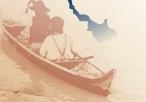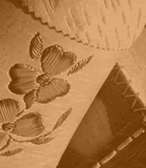The fur trade provides an example of how northern Aboriginal peoples adapted
to the arrival of Europeans. Fur trading firms such as the Hudson's Bay Company,
the Northwest Company and other independent traders first came north in the
late 18th century. The Dene* were skilled hunters and adapted easily to the
demands of the fur trade. Out of this relationship grew new positions of influence
within Dene bands as trading chiefs emerged.
One of the most prominent trading chiefs was Bear Lake Chief, or Francis Yambi,
as he was called in church records, a Dogrib who traded at Old Fort Rae and
later at Fort Norman. Bear Lake Chief was greatly respected by traders and explorers
for his vast knowledge of the region, and he was a very good provider for his
people. You can learn more about Bear Lake Chief in the "Trading Chiefs" section
of this site.
*The word "Dene," meaning "people," is used by the Athapaskan-speaking
Aboriginal people of the Northwest Territories to represent their political
unity. Dogrib is one of the Dene or Athapaskan languages in the NWT and is therefore
part of the Dene Nation.

